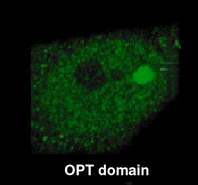 | OPT domains (Oct1/PTF/Transcription), are transcriptionally active domains rich in PTF, Oct1, TBP, SP1, and RNA pol II (reviewed in Spector, 2001)  . These domains are 1.0-1.5 mm in diameter and, in addition to transcription factors, they also contain nascent transcripts (Grande et al., 1997; Pombo et al., 1998) . These domains are 1.0-1.5 mm in diameter and, in addition to transcription factors, they also contain nascent transcripts (Grande et al., 1997; Pombo et al., 1998)  . Each mammalian nucleus contains between one to three OPT domains that appear in G1, usually in close proximity to nucleoli, only to disappear in S phase. . Each mammalian nucleus contains between one to three OPT domains that appear in G1, usually in close proximity to nucleoli, only to disappear in S phase.
Although the function of these bodies is unkown, a small region on chromosome 6 (band 6p21) and chromosome 7, associate with the domain significantly more than other chromosomes (Pombo et al., 1998)  . Therefore OPT domains, like . Therefore OPT domains, like |